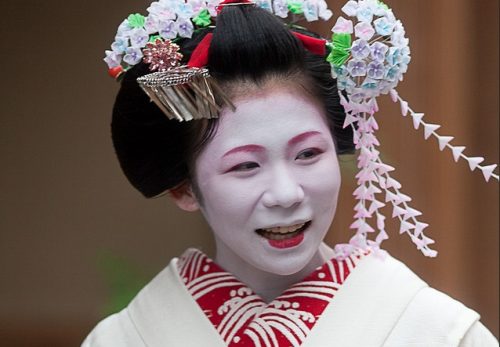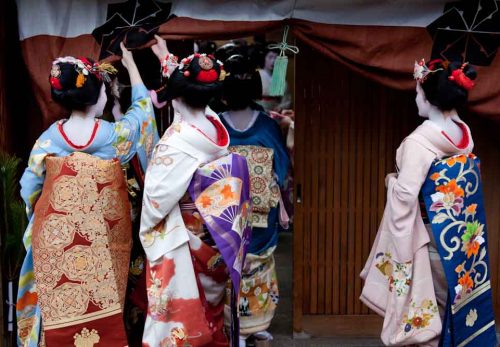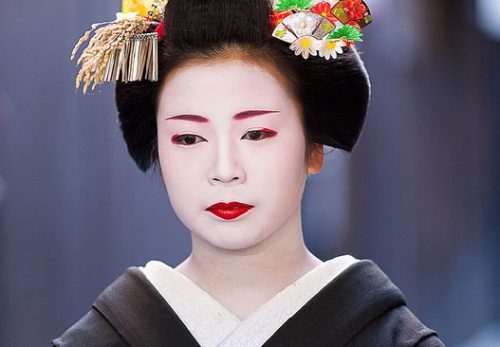Winter Kyoto starts with a kabuki show with an all-star cast,Kaomisekogyo

Maiko and geiko of Gion-kobu showed up for kaomisekogyo on 11th
“Kaomise”means to show faces in Japanese . And “Kaomisekogyo” is a glorious festive performance that kabuki actors show up at a prestigious theater, Minami-za in Shijo-dori street, Higashiyama. It is one of the biggest events liven up beautiful winter ofKyoto. Every year, show starts on the last day of November and goes on for 26 days.
At beginning of Edo period, there were two playhouses near Shijo-ohashi. One was called Kita-za, the other was the Minami-za. It is said that the two competed to show their actors for so-called ‘public relations’ and Kaomisekogyo originates in these activities.
“When I see ‘maneki kanban’ decorated above the entrance of Minami-za Theater, that’s the sign for December’s arrival and I deeply feel a change of season.”One man who was born and bred in Kyoto says.
‘Maneki kanban’is a wooden signboard with kabuki actor’s name on. The board is all made in Japanese cypress, for each maneki, names are written with Chinese ink all by hand. It might be a little hard to figure out actual impact as it was taken from opposite side of Shijo-dori. But please have a closer look at a picture below.

Minami-za Theater on kaomisesoken day
How is it? Don’t you feel something powerful!? All letters are written in a unique calligraphy style called ‘Kanteiryu’. It is just so dynamic.
“Lines must be thick, they should never be patchy.” “Use whole space of signboard to write letters. Do not leave too much spaces and gaps.”and so on… To wish a peaceful success of this event, there are some rules to follow in writing manners. It was all written by a Japanese calligrapher, Seiho Kawakita.
Surprisingly, length of each maneki is approximately 6 feet! If you stood in front of Minami-za and look up 54 manekis put up for this year, I bet you would naturally give a salute in spite of yourself. They were so vibrant with vitality like kabuki actors full of energy, I felt a rise in my body temperature at heat by just viewing them.
Superb days in December! All maiko and geiko from every hanamachi visit to view the show
And here is ‘Kaomisesoken’. As explained earlier, ‘kaomise’ means to show faces. During Kaomisekogyo, maiko(geisha) and geiko(mature geisha) from each flower town visit Minami-za to view kabuki plays at balcony seats.
Since it is said to be auspicious to go under ‘maneki display’, each kaomisesoken takes place within few days after the event starts. This year, it was Miyagawa-cho on 3rd of December, Ponto-cho on 4th, Kamishichiken on 5th,Gionhigashi on 6th and Gion-Kobu on 11th .
In Kyoto, it is normally about the time to snow now. But because of the fact that all maiko and geiko gather in this special place, whole town is wrapped in an air of full excitement. “Has the next summer arrived already?”It is so hot that you could have guessed a season wrong.

On the way to Minami-za theater… Presence of maiko adds to the gaiety of street
On the stage of Minami-za, you have great kabuki actors, and there are graceful maiko and geiko dressed in beautiful outfits sitting on either side. Imagine a luxurious time it could be. There is no reason for general customers not to book seats on kaomisesoken days and I am told that there are so many people coming to the theater in fact.
And more, there are amateur cameramen waiting for them to come out at the entrance of Minami-za. Just to capture splendid appearance of them.
There are several kaomisekogyo all over in Japan. Among them, the one at Minami-za is the oldest and the most important performance in Japanese kabuki. Even more importantly, this year was exceptionally rare as a name succession ceremony for Kankuro Nakamura the sixth was planned to be held.
Sadly, Kankuro Nakamura the fifth (a father of Kankuro Nakamura the sixth, also known as Kanzaburo Nakamura the 18th) died on the day before. It was shocking news for Japan, but for people in flower towns which have prospered with kabuki plays for a long time, the shock was even more intense.
For both maiko and geiko, kaomisesoken is a great place to communicate with ‘comrades’ whose profession is also to entertain people with skilled performances. It is a great opportunity for them to learn accomplishments too.
But for customers in theater, they all have duties to promote the event and a town of Kyoto as leading actors at the same time. And again, they had to deal with a sudden death of great kabuki master in the middle of event. Can you imagine how hard it can be?
One day, I looked at them on balcony seats. From beginning to end, their backs were straightened up, and every one of them looked supple with bright smiles on their faces.
If you had a chance to visit, I recommend you to be there with them. It is almost like a magic when their appearance calms down the whole scene in a theater and added grace to the event.
But their eyes gazing at actors on stage were so upright and hot. It was like a roaring passion which is a lot redder than vermillion parapet in a theater. Aren’t they so great? I admire.
Maiko’s Kanzashi in December

Maiko, Toshiteru san of Miyagawa-cho
Among other things, kanzashi for maiko(geisha) in December has a daring design. It is decorated with miniture ‘maneki kanbans’ and ‘mochibana’ ornaments. There are two manekis dangling from kanzashi itself, so they sway in a breeze as maiko(geisha) walks and it looks so stylish.
There are various decorations like battledores and welcoming cats in many colors. It is just fun to look at details.But nothing is written on ‘mankei kanban’ until maiko visit Minami-za for Kaomisesoken.
“Why blank? Didn’t you say it is a signboard to write kabuki actor’s name? ” -Yes, it is so. The fact is that there is a secret pleasure for maikos on that very day of kaomisesoken.
During an intermission in a play, they all visit dressing rooms of favorite kabuki actors individually and get them signed! This is why it is kept blank till then.

Kanzashi with two maneki signed by kabuki actors
The leading actors sign in black while female-role players write in vermillion-colored ink by hand. Unfortunately, I have never seen when they sign as I do not have the privilege of free access to a dressing room like maikos, but I had a chance to asked a man concerned.
“Does maiko wear kanzashi when an actor signs? ” -“Well, I guess she takes it off from her coiffure once and get it signed. In most of the cases, it is like that.” Even after kaomisesoken completed, all maikos in town wear kanzashi with signed manekis during December.
Talking about the other motif, mochibana, it is not a real flower. Originally, it is one of ornaments for ‘preliminary celebration’. Rice cakes and dumplings are rolled up into small balls and decorated on branches of willows and some other kinds of trees.
Depending on the regions, there are various meanings, but it is said that mochibana is often decorated to wish a huge harvest on New Year’s Day according to the old calendar. And maiko’s kanzashi adopted this custom.
A delicate flower to taste with eyes-If I were to give it a catchphrase, I would name it like this. Though it might be a little indiscreet, mochibana’s round shape stimulates my appetite so much.
Wandering from the subject ‘kanzashi’, but there is one more round thing that I like to introduce. ‘Kagami-mochi’ is a huge, flat and circular rice cakes and generally known as New Year’s offerings for deities and Buddhas.
In flower towns of Kyoto, people start preparation for New Year on every 13th of December, maiko and geiko go around town to pay courtesy calls with the rice cakes. The day is called ‘kotohajime’.

Photos:Copyright(c)2012 Geisha Japan All Rights Reserved
Special Thanks to: WALKKYOTO http://walkkyoto.exblog.jp/i30/











この記事へのコメントはありません。